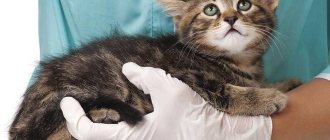Some cat owners, when acne appears on their pet's chin, do not perceive it as a serious danger. Most people hope that acne will disappear on its own after some period of time. But, as practice shows, ignoring this problem often leads to dangerous consequences for the health of the animal. In order not to lead to a worsening of the situation, everyone should know what can contribute to the development, how the pathology manifests itself, and also what measures should be taken to get rid of it.
What are black dots on a cat's face?
If you find black spots on your cat's chin, first of all you should make sure that these are acne. After all, dark rashes can be the result of parasite excrement or dried droplets of blood. To check your assumptions, you need to try to remove the dots; if nothing works, then it means acne.
Acne on a cat's chin
Every person who has a cat at home should understand that the animal’s skin is covered with sebaceous glands. When exposed to unfavorable factors, the pores become clogged and plugs form. This process is quite lengthy and can take place over several years.
The plugs, which are subcutaneous fat, become black as a result of oxidation. If treatment is not started in time, the problem can develop into an inflammatory process.
Black spots on a cat's chin can appear either immediately or gradually. Most often, rashes occur on the lower lip, chin and around the neck. In advanced cases, the disease progresses and causes acne to spread to the thighs and abdomen.
Note! Every animal can face the problem of blackhead formation. In this case, the pathology develops very slowly. The pet begins to experience discomfort only in the later stages.
Types of acne in cats
Main causes of rashes
A cat has diarrhea with blood: what to do and how to treat it
If black specks appear on a cat's chin, then this condition can be caused by numerous factors. Most often, problems arise as a result of the individual characteristics of the animal’s body. To reduce the amount of blackness, you need to carefully care for your pet.
The reasons that provoke this condition also include:
- poor nutrition;
- pathologies of the sebaceous glands;
- hormonal disorders;
- liver diseases;
- decreased immunity.
To determine the cause of the problem, it is recommended to immediately contact a veterinarian at the first sign.
Poor hygiene
The most common problem. As a result of poor quality care, blackheads and dark-colored pimples appear on the cat’s body. This occurs due to the large accumulation of sebaceous glands. Excessive care for your pet can also lead to the development of pathology.
Hormonal disbalance
Both humans and cats can experience hormonal imbalances. As a result of this, several diseases arise. The most common is the appearance of blackheads. The cause of the pathology may be improper behavior of the owner, overfeeding, inappropriate food, as well as improper behavior of the owner and taking hormonal medications.
Infection
Problems with the skin are observed even in cats that do not go outside and are properly cared for by their owners. Cats often develop black acne as a result of infections. As a result, your pet develops painful ulcers.
Causes of rashes depending on location
Your cat has worms: how to treat them at home
According to experts, one of the most common causes of blackheads in cats is pollution. But at the same time, this condition can be a consequence of other reasons.
Black spots on the lower jaw
Dark-colored sores can appear on the lower jaw in cats due to hereditary predisposition. In this case, you can ensure the normal condition of the skin with the help of properly selected hygiene products.
Black dots on a cat's lower jaw
On the lips
Having noticed black spots on a cat's lips, every owner should be wary. This manifestation may indicate the development of fungal diseases. At the first signs, it is important to immediately seek qualified help, since it is impossible to independently determine the type of infection.
Acne on a cat's lips
In the mouth
Sometimes attentive and caring owners may discover that black spots have appeared in the cat’s mouth. Basically, such a deviation indicates natural processes that do not pose a threat to the health and life of the pet. But still, in rare cases, this may indicate the development of pathology.
Important! Black spots in the mouth can appear as a result of normal pigmentation, allergic reactions, stress, dirty dishes, poor environmental conditions, and oncology.
Diagnosis and treatment methods
The therapeutic course for spots on the nose is selected by the veterinarian based on the diagnostic results. The main thing in making a diagnosis is a laboratory test to determine the pathogenic microflora that caused the rash on the face. Blood and urine tests may be required. For black spots, local treatment is prescribed, but for advanced cases of the disease, an integrated approach is required using medications from different groups.
Among the antiseptics, Miramistin is suitable for animals.
When rashes on a cat’s nose are associated with an allergic reaction, drugs with antihistamines come to the rescue. For daily treatment, antiseptics are used, such as:
- "Miramistin";
- "Chlorhexidine."
When spots on a cat’s nose are caused by a dermatological disease, antibacterial agents that suppress the activity of pathogenic microorganisms are necessarily used for treatment. It is equally important to adjust your pet’s diet by eliminating fatty foods and adding more fresh food. Omega-3, 6 and vitamin supplements help strengthen the cat’s immune system and prevent the appearance of other spots. It is possible to use folk remedies, such as a decoction of chamomile or celandine, which is used to treat the cat’s nose.
Treatment for black spots on the chin in cats
Snot in a kitten, cat and cat: how to treat it
If black specks appear on your cat's chin, it is important to immediately seek qualified help. At a veterinary clinic, a specialist will determine what the disease is like and select the most effective treatment.
Most often, it is recommended to treat a cat with products intended for local treatment. For this purpose, special shampoos, tar soap or antiseptic solutions are used. For advanced diseases, medications and injections are prescribed and adjustments to the usual diet are recommended.
Improved pet care
A pet with this disease does not require special care. It will be enough to follow the recommendations given by the veterinarian. You can speed up the healing process by daily washing your cat's bowls from which the animal drinks and eats.
During the treatment process, it is very important to systematically remove dirt and food debris from your pet’s chin and gums. It is best to do this after every meal.
Treatment with antiseptics
If black crusts or dots appear on a cat’s face, experts recommend treating them with antiseptics. You can cure acne in a kitten or adult cat using tar soap. The affected area should be treated with it several times a day.
As for antiseptics, it is recommended to use hydrogen peroxide or chlorhexidine for pets. These drugs are used to treat the mouth and affected areas. 15 minutes after this, it is recommended to apply a cotton piece of fabric soaked in a hot decoction of calendula to the sore spot. Then the lesion should be wiped with salicylic acid, and then an ointment for acne in animals should be applied.
Antiseptic treatment of black spots on the chin of cats
Bathing with special shampoos
To help the animal get rid of black spots on the body, special antiseborrheic shampoos are used. They recommend washing the cat several times a day if pathology is observed throughout the body. If the disease manifests itself in certain areas, then it is enough to bathe the pet once a day.
When to go to the vet
It is almost impossible to determine on your own why a cat has black spots on its chin. If the disease begins to develop and the skin at the site of the lesion begins to go bald, then this is a sign that signals that you need to contact a veterinarian immediately.
Whiskers on cats
Many people wonder whether cats have black whiskers and why they fall off and break off. It will be equally interesting to find out what they are correctly called and what function they perform in cats, cats and kittens, because few of those who keep such cute pets in an apartment or private house know about this.
The article discusses basic questions about cat whiskers, interesting facts and everything that every cat lover should know about their pet, so that in case of any problem, they can correctly provide help and know what needs to be done.
What are cats' whiskers called?
Whiskers in cats are scientifically called vibrissae. It is believed that a cat's whiskers are thickened and coarse hairs endowed by nature with mechanical sensitivity.
Is it possible to cut or trim a cat's whiskers?
Trimming a cat's whiskers is strictly contraindicated. A cat without a mustache will not be able to navigate in space. Whiskers serve as tactile and olfactory receptors.
Why does a cat need mustaches and eyebrows, what are they needed for, what are they responsible for
Whiskers and eyebrows in cats (more correctly whiskers) are needed so that the animal can navigate in space. These are natural navigator antennas.
Why do cats and kittens' whiskers break, fall out, and become long?
Periodic loss of whiskers in cats, with replacement with new ones, is the norm. If the whiskers fall out or break off intensively, this is a sign of a malfunction in the animal’s body.
Mustache loss can be caused by: - lack of vitamins; - due to food allergies; — malfunctions of the thyroid gland; - skin diseases of a fungal nature or caused by parasites (notoedrosis or microsporia).
It is paradoxical, but true, that long and thick whiskers in cats are not always a sign of excellent health. Scientists have found that their carriers often have impaired vision.
Why do cats have white whiskers and turn white?
A sharp change in the color of the mustache to white may indicate the onset of a disease, for example, giardiasis. It is clear that without a clinical examination it is impossible to establish an accurate diagnosis, and therefore the cause of the whitening of the cat’s whiskers. Sometimes the whiskers of a healthy animal turn white, but it’s better to be safe and resolve your doubts.
Why do cats' whiskers turn black?
Black whiskers in cats are not associated with any disease, so there is no reason to worry. The color change is caused by modifier genes.
Do cats' whiskers grow and grow?
Cats' whiskers are periodically renewed - they fall out and grow back. But specifically cutting (to make it thicker) or straightening (to make it more beautiful) a cat’s mustache is strictly contraindicated. Whiskers on cats and cats are a matter of touch, not charm.
Do hairless cats have whiskers?
Hairless cat breeds may have subtle, broken and curled whiskers. The complete absence of this source of pride for their short-haired and long-haired counterparts is also considered normal.
My cat's whiskers are breaking, what should I do?
Broken whiskers in a cat indicate a lack of vitamins and calcium in its body, and less often - damage by microbes and fungi. You can correct the situation by giving your pet cottage cheese, vegetables or ready-made vitamin and mineral supplements.
Whiskers on a cat's paws and nose
Cats have whiskers not only on their faces, but also on their paws. The length of the usual cat whiskers on the cheeks of the animal is about 7 cm. The world record holder in this area is the Maine Coon Missy, a resident of Finland, who grew a 19 cm mustache. Our compatriot from Tver, a red cat called Krepysh, has more modest figures - 13.5 cm.
The whiskers on the paws, in this case it would be more appropriate to call them scientifically, vibrissae, are located on the underside of the forelimbs. They can be distinguished from wool by their greater thickness and stiffness.
comments 3
- 3 Comments
- 0 Trackbacks & Pingbacks
- Dasha:
12/03/2016 at 18:34easily
- Sergey:
05/29/2017 at 17:07
If you cut off a cat's whiskers, will they grow back?
- Natalia:
11/30/2018 at 6:27 pm
Tell me, there are also antennae on the side of the nose, small black ones, sticking out... What are these antennae for?
Add a comment Cancel reply
Rash prevention
To prevent black spots from appearing on the animal’s body, it needs to be provided with good living conditions and fed only from a glass, iron or ceramic bowl. In addition, it is imperative to clean the animal, give it vitamin complexes and ensure a balanced diet.
Cleaning your pet
It is necessary to carefully monitor the cleanliness of your pet's fur, especially on the chin. To prevent contamination, you should bathe your pet with special shampoos.
Balanced diet
A balanced diet will help speed up the healing process and prevent the development of the disease. In this case, it is best to give preference to specialized products that are suitable for a specific breed. Experts recommend feeding your pet not only dry food, but also including boiled fish, chicken, eggs, carrots and grass in the diet.
Note! It is strictly forbidden to feed your pet cheap food, as it contains a large amount of preservatives and flavorings.
Balanced nutrition for cats
Vitamin complexes
A loving owner must provide his pet with a sufficient amount of vitamins. They must be contained in food, so preference should be given to special balanced feed of good quality. In addition, the animal should be systematically given vitamin complexes that will ensure the health and well-being of the pet.
Black spots on a cat's chin may indicate a pathology that occurs when the sebaceous glands become inflamed. When abnormalities appear, the animal feels well at first, but symptoms of the disease appear after a long time. The domestic cat becomes like a yard cat and is unkempt. Why this happens and how to cope with the pathology can only be suggested by a specialist who will professionally determine the cause and prescribe qualified treatment.
Causes and diseases that cause black plaque to appear
Ear mites are not the only culprit of ear plaque. There are several other diseases that cat owners should pay attention to:
Otodectosis or ear scabies
A disease caused by a tick. Treatment may be prescribed depending on the severity of the disease. If the owner has only recently noticed the appearance of a black plaque that the cat has not had before, you can buy the necessary drops or aerosols at a veterinary pharmacy and treat the animal yourself. If there are obvious complications in the form of bruises, scratched ears and inflammation, only a veterinarian can provide assistance.
Formation of sulfur plugs
If the cat breed has an unusual ear structure (for example, Sphynx), wax plugs may become the No. 1 problem that the owner will have to face.
Black plaque in these cats is the result of excessive wax build-up in the ears.
It accumulates in large volumes, does not clean itself and becomes a favorable environment for various microbes.
Sulfur itself does not cause any discomfort to the pet, but the presence of bacteria can greatly darken the cat’s life. To prevent inflammation, it is enough to carefully clean your cat's ears of wax plugs at least once a month. To remove large plaque deposits, it is better to purchase a special lotion from a veterinary pharmacy. If the remedy does not produce results, contact a veterinarian immediately.
Be sure to read the article on how to clean your cat’s ears yourself.
Otitis
A disease that requires a serious response from the cat owner. Otitis can be external, medial and internal.
With external otitis, the symptoms are the same as with a tick - a dark coating in the ears and restless behavior of the cat, when it often scratches its ears, as if trying to remove something from there.
The next stage of the disease is medial otitis, which is more difficult to cure than external otitis. At this stage, you need to urgently contact a veterinary clinic.
With medial otitis, signs such as:
- discharge of fluid from the ears;
- an unpleasant odor is felt from a distance;
- change in the cat’s behavior, she does not allow her ears to be touched;
- refusal to eat.
The most extreme and dangerous stage of the disease is internal otitis. Under no circumstances should this be brought to this point, because... The cat may lose hearing.











